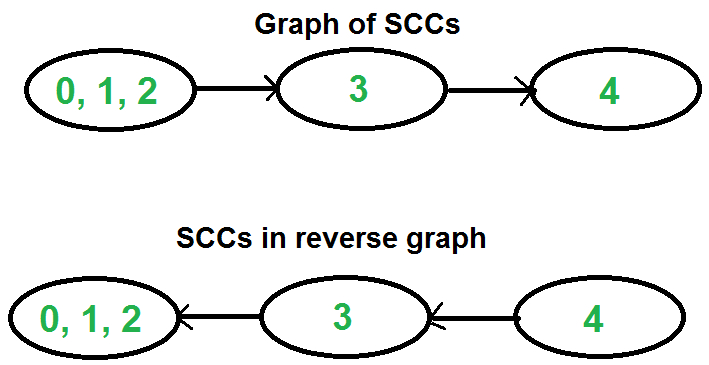有向图 G = (V, E) 的一个强连通分支(SCC:Strongly Connected Components)是一个最大的顶点集合 C,C 是 V 的子集,对于 C 中的每一对顶点 u 和 v,有 u --> v 和 v --> u,亦即,顶点 u 和 v 是互相可达的。
实际上,强连通分支 SCC 将有向图分割为多个内部强连通的子图。如下图中,整个图不是强连通的,但可以被分割成 3 个强连通分支。

通过 Kosaraju 算法,可以在 O(V+E) 运行时间内找到所有的强连通分支。Kosaraju 算法是基于深度优先搜索(DFS),算法的描述如下:
- 创建一个空的栈 S,并做一次 DFS 遍历。在 DFS 遍历中,当在递归调用 DSF 访问邻接顶点时,将当前顶点压入栈中;
- 置换图(Transpose Graph);
- 从栈 S 中逐个弹出顶点 v,以 v 为源点进行 DFS 遍历。从 v 开始的 DFS 遍历将输出 v 关联的强连通分支。
例如,对于上面的图做第一次 DFS 遍历,然后反转图,则可理解为整个图中的边的方向均反转了。

下面是 Kosaraju 算法的 C# 实现。
1 using System; 2 using System.Collections.Generic; 3 using System.Linq; 4 5 namespace GraphAlgorithmTesting 6 { 7 class Program 8 { 9 static void Main(string[] args) 10 { 11 Graph g = new Graph(5); 12 g.AddEdge(1, 0, 11); 13 g.AddEdge(0, 3, 13); 14 g.AddEdge(2, 1, 10); 15 g.AddEdge(3, 4, 12); 16 g.AddEdge(0, 2, 4); 17 18 Console.WriteLine(); 19 Console.WriteLine("Graph Vertex Count : {0}", g.VertexCount); 20 Console.WriteLine("Graph Edge Count : {0}", g.EdgeCount); 21 Console.WriteLine(); 22 23 List<List<int>> sccs = g.Kosaraju(); 24 foreach (var scc in sccs) 25 { 26 foreach (var vertex in scc) 27 { 28 Console.Write("{0} ", vertex); 29 } 30 Console.WriteLine(); 31 } 32 33 Console.ReadKey(); 34 } 35 36 class Edge 37 { 38 public Edge(int begin, int end, int weight) 39 { 40 this.Begin = begin; 41 this.End = end; 42 this.Weight = weight; 43 } 44 45 public int Begin { get; private set; } 46 public int End { get; private set; } 47 public int Weight { get; private set; } 48 49 public override string ToString() 50 { 51 return string.Format( 52 "Begin[{0}], End[{1}], Weight[{2}]", 53 Begin, End, Weight); 54 } 55 } 56 57 class Graph 58 { 59 private Dictionary<int, List<Edge>> _adjacentEdges 60 = new Dictionary<int, List<Edge>>(); 61 62 public Graph(int vertexCount) 63 { 64 this.VertexCount = vertexCount; 65 } 66 67 public int VertexCount { get; private set; } 68 69 public IEnumerable<int> Vertices { get { return _adjacentEdges.Keys; } } 70 71 public IEnumerable<Edge> Edges 72 { 73 get { return _adjacentEdges.Values.SelectMany(e => e); } 74 } 75 76 public int EdgeCount { get { return this.Edges.Count(); } } 77 78 public void AddEdge(int begin, int end, int weight) 79 { 80 if (!_adjacentEdges.ContainsKey(begin)) 81 { 82 var edges = new List<Edge>(); 83 _adjacentEdges.Add(begin, edges); 84 } 85 86 _adjacentEdges[begin].Add(new Edge(begin, end, weight)); 87 } 88 89 public List<List<int>> Kosaraju() 90 { 91 Stack<int> stack = new Stack<int>(); 92 93 // Mark all the vertices as not visited (For first DFS) 94 bool[] visited = new bool[VertexCount]; 95 for (int i = 0; i < visited.Length; i++) 96 visited[i] = false; 97 98 // Fill vertices in stack according to their finishing times 99 for (int i = 0; i < visited.Length; i++) 100 if (!visited[i]) 101 FillOrder(i, visited, stack); 102 103 // Create a reversed graph 104 Graph reversedGraph = Transpose(); 105 106 // Mark all the vertices as not visited (For second DFS) 107 for (int i = 0; i < visited.Length; i++) 108 visited[i] = false; 109 110 List<List<int>> sccs = new List<List<int>>(); 111 112 // Now process all vertices in order defined by Stack 113 while (stack.Count > 0) 114 { 115 // Pop a vertex from stack 116 int v = stack.Pop(); 117 118 // Print Strongly connected component of the popped vertex 119 if (!visited[v]) 120 { 121 List<int> scc = new List<int>(); 122 reversedGraph.DFS(v, visited, scc); 123 sccs.Add(scc); 124 } 125 } 126 127 return sccs; 128 } 129 130 void DFS(int v, bool[] visited, List<int> scc) 131 { 132 visited[v] = true; 133 scc.Add(v); 134 135 if (_adjacentEdges.ContainsKey(v)) 136 { 137 foreach (var edge in _adjacentEdges[v]) 138 { 139 if (!visited[edge.End]) 140 DFS(edge.End, visited, scc); 141 } 142 } 143 } 144 145 void FillOrder(int v, bool[] visited, Stack<int> stack) 146 { 147 // Mark the current node as visited and print it 148 visited[v] = true; 149 150 // Recur for all the vertices adjacent to this vertex 151 if (_adjacentEdges.ContainsKey(v)) 152 { 153 foreach (var edge in _adjacentEdges[v]) 154 { 155 if (!visited[edge.End]) 156 FillOrder(edge.End, visited, stack); 157 } 158 } 159 160 // All vertices reachable from v are processed by now, 161 // push v to Stack 162 stack.Push(v); 163 } 164 165 Graph Transpose() 166 { 167 Graph g = new Graph(this.VertexCount); 168 169 foreach (var edge in this.Edges) 170 { 171 g.AddEdge(edge.End, edge.Begin, edge.Weight); 172 } 173 174 return g; 175 } 176 } 177 } 178 }
输出结果如下:

参考资料
- Connectivity in a directed graph
- Strongly Connected Components
- Tarjan's Algorithm to find Strongly Connected Components
本篇文章《Kosaraju 算法查找强连通分支》由 Dennis Gao 发表自博客园,未经作者本人同意禁止任何形式的转载,任何自动或人为的爬虫转载行为均为耍流氓。